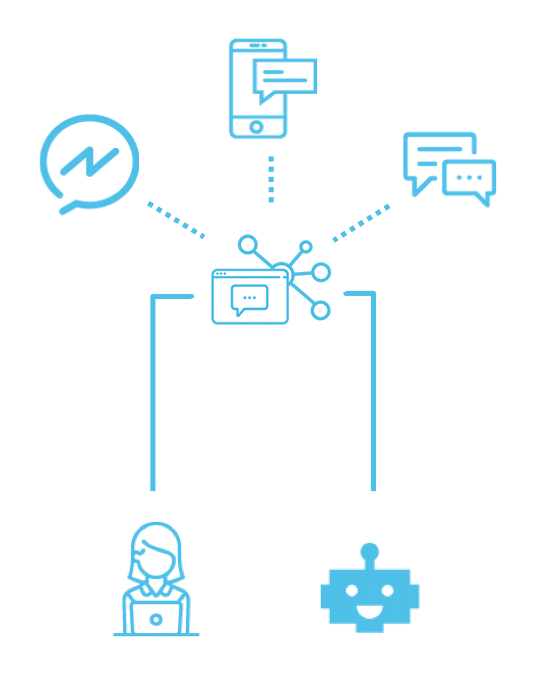In these times of hyperconnectivity, digital customer care requires the use of a wide range of tools on a daily basis. These include CRM systems, digital customer interactions platforms, reporting tools, voice tools … All of these generate a large amount of data, all of which is formatted independently.
To provide the best possible customer experience and optimize their business, it is essential for companies to be able to synchronize this data. In this article, we are introducing how an Open Platform allows answering these connectivity issues. We are also giving an overview of all tools used in a customer care department and how they interact together.
Open platforms for developing connected ecosystems
By favoring the development of a connected tool ecosystem, the Open Platform concept makes it possible to respond to these challenges. By using open APIs, the Open Platform allows the interconnection of tools, meaning they are able to communicate and exchange data. Thus, any type of tool offering APIs can be connected to an open platform. It is also possible to integrate the platform on another interface.
This type of platform is very flexible and can adapt to the specific needs of each company, depending on its issues and tools.
What customers see versus reality
When customers contact a company, they focus on their interaction with a customer service agent, via means of a communication channel. Digital communication channels, such as messaging, make it possible to contact a customer service agent at any time from a mobile phone, meaning customers are not constrained by company telephone operating hours and their interactive voice servers. These technologies make customer service exchanges much easier and facilitate the development of closer relationships. Customers thus have a very simplified view of customer service, which includes 2 or 3 main blocks.

However, the reality is much more complex and many tools are used to ensure the effective handling of this interaction. These include, amongst others, CRM systems to provide transactional information, workforce management tools to plan the number of agents needed, digital interactions platform to allow agents to process messages.
Disconnected tools versus open platforms: concrete examples
An integrated CRM to obtain a 360 ° view of the customer
To better illustrate these issues and the value of an open platform, let’s take a look at some examples of good customer service situations. By comparing them based on the presence of interconnected tools, it becomes easier to understand the value of an open platform.
Imagine a situation where a customer needs to contact his telecoms operator by email. Within a disconnected system, the information is not circulated between the different tools. Agents respond via an interaction management platform but will not be able to easily access the information stored in the CRM system. In order to identify the client, they will have to ask for information such as their contract number. They will then have to use a different interface to be able to access the client’s file. This means a longer processing time, resulting in a more onerous experience for the customer, and additional costs for the company.

On the contrary, when tools are connected, the experience is much smoother for the agent and the customer. The integration between the CRM and the Digital Interaction Platform makes it possible to synchronize transactional and conversational data. This means all the necessary information is available to direct messages to the right agent, which in turn prevents the need for rerouting calls.
In addition, the identity of the customer can be recognized from the beginning of the exchange. Thus, the agent does not need to ask different questions to identify the client, and can directly access exchange history and the relevant contracts. This approach provides a smoother experience across all the different channels.
A connected chatbot to ensure a smooth transition to an agent
Increasingly common in the field of customer relations is the interaction with chatbots. This type of programme provides customers with automatic responses. Benefits include freeing up time for customer service agents and a 24/7 service.
Imagine a scenario where a customer wants to interact with his telecoms operator due to a blocked SIM card. By starting a discussion on Messenger with the brand, the customer enters into a conversation with a chatbot and is asked to describe the nature of the problem. Among the options offered, it is not possible to choose “My SIM card is blocked“. The customer therefore chooses the option “I have another question, “I want to speak with an agent“. Since this particular problem is not foreseen in the scope of the chatbot, the latter option offers the customer the opportunity to be contacted by phone by an agent to solve their problem.
If we now consider the same scenario with a company using an open platform:
Facing a problem with a blocked SIM card, the customer initiates a conversation on Messenger. In the same way as with the initial scenario, the customer selects the option “I have another question, I want to speak with an agent“. Once the customer clicks to send this message, the open digital interactions platform, connected to both Messenger and chatbot, detects the phrase “I want to speak with an agent“. Thanks to this expression, the open platform assigns the conversation to an agent available on Messenger. The customer is then put in touch with an agent and can be assisted without changing communication channels.

In this example, the company has decided to use a chatbot on Messenger for specific requests. Since a chatbot is not able to handle all requests, it is important to provide a ‘redirection to an agent’ option.
In the first scenario, the experience does not run smoothly. The customer is obliged to use another communication channel, entailing a further delay, and has to explain their problem for a second time.
In the second scenario, the transition from chatbot to agent is seamless: the client is instantly redirected to an agent, and can continue his conversation using the same communication channel. Since the history of the exchange with the chatbot is transferred to the agent, the latter does not have to ask the customer again for information about their identity or problem. The agent directly assists the customer and help to unlock their SIM card.
Conclusion
As these examples outlined, interconnected tools allow to provide a much more seamless experience. Some of the most common customer frustrations include long wait time, the need to explain the issue multiple times and redirects to different channels. The cause of many of these frustrations is the lack of connectivity between customer service apps.
When contacting companies, customers just want to see their problem solved and should not be dependent on companies’ internal processes. By connecting to other tools through APIs, an open platform helps companies to answer this challenge.
Updated Oct 15, 2025











